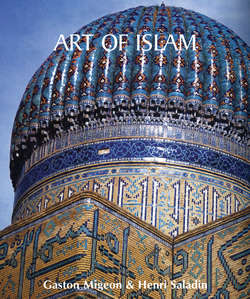Art of Islam

Реклама. ООО «ЛитРес», ИНН: 7719571260.
Оглавление
Gaston Migeon. Art of Islam
Introduction
Architecture
A – The Near and Middle East
Cairo
Jerusalem
Mecca
Medina
Damascus
The Mosque of Ibn Tulun in Cairo
The Al-Azhar Mosque in Cairo
The Hassan Mosque in Cairo
B – North Africa and Spain
Palaces
The Hassan Tower in Rabat (1199)
The Koutoubia Mosque in Marrakech
Marrakech
The Great Mosque of Tlemcen
The Giralda (1195)
The Great Mosque of Córdoba
The Alhambra
C–Iran and the Persian School
Bricks
Stalactites
Roofs
Ornamentation
Baghdad
The Friday Mosque of Isfahan
Tamerlane’s Mausoleum (Gur-e Amir)
The Sher-Dor Madrasa
Monuments of Isfahan: Shah Abbas’s Constructions
The Imperial Mosque at Isfahan
D – The Ottoman School
The Great Mosque of Konya
The Bayezid II Mosque
The Suleymaniye Mosque
The Selimiye Mosque at Edirne
The Sultan Ahmed Mosque
E – Muslim India
Qutab Minar
The Monuments of the Mughal Emperors
Badshahi Mosque (Lahore)
The Taj Mahal in Agra
The Delhi Palace
The Palace of Jaipur
The Golden Temple in Amritsar
The End of Indian-Muslim Architecture
Fine Arts
A – Sculpture
Sculpted wood
Ivory
B – Metal Arts
Bronze
Copper Inlays
Weapons
C – Metalwork and Rock Crystals
D – Mosaics
Manufactured Products
A – Ceramics
Hispano-Moorish Faience
B – Enamelled Glass
C – Textiles
D – Carpets
The Art of the Book
A – Arab Manuscripts
B – Egyptian Korans
C – Persian Manuscripts
D – Indo-Persian Miniatures
E – Turkish Manuscripts
Conclusion
Bibliography
Отрывок из книги
Within a century, the Arab conquests that spread rapidly into the East, North Africa and Spain upset the social fabric of all the subjugated peoples by imposing not only a new religion and organisation, but also new customs and practices. One religion alone orchestrated the spread of a single statute. Although still reeling in the aftermath of barbarian conquests and torn by sectarian conflicts among Christians, the ruined former Roman provinces became the cradle of a new world, the Muslim world, which for centuries was more civilised than most countries in Europe. Since Muhammad had promised his followers that they would possess the kingdoms of the world, the enjoyment of material things was viewed as a gift and a reward, not as a despicable pleasure to be shunned by the faithful. Consequently, Muslim leaders sought to surround themselves with luxury and decorated their cities and palaces. The ostentation of caliphs became proverbial, and throughout their empire imposing monuments sprang up whose opulence and elegance remained legendary in the East.
The Muslim civilisation, forged by the efforts of many different people, was not composed solely of Arabs. Consistent with the models that influenced it and the places where it grew, it also included Greeks, Persians, Syrians, Egyptians, Spaniards and Indians. Considering all origins together, however, Arabs, although never so far accurately defined, unquestionably made up the greatest number. This background notwithstanding, they were able to fuse these greatly diverse elements into one homogeneous blend and build a civilisation that bears the mark of their genius. The art of Felix Arabia, ancient Yemen, cannot be left out of a list of countries that influenced early Islamic art. The primary result of Islamic conquests was a kind of blend of Eastern and Western artistic traditions.
.....
Prayer hall in the Great Mosque of Damascus, 706–715.
Mihrab and minbar of the Great Mosque of Damascus, 706–715.
.....